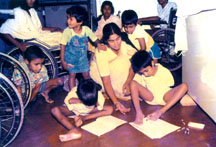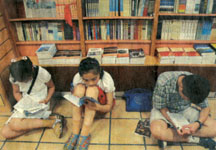
Vocational training for disabled children
At school, on the roads or in various public places, you may have
come across many disabled children. You may have relations who have been
disabled due to a variety of reasons, or you yourself may have some kind
of disability. Just because one is healthy or physically sound now, that
doesn't mean they should insult the disabled. Disability could happen to
anybody at any time; all the more reason for you to be kind and
compassionate to victims.

However, being disabled doesn't mean being unable. Such people are
abled in different ways. They may be able to perform certain tasks even
better than 'normal' people.
There's no reason to ignore these differently-abled people either.
With the right education and training, they can also contribute
something to society, and not be burdens.
It is with this idea that the Ministry of Social Services and Social
Welfare initiated a Vocational Training Institute for disabled children.
It is located at Seeduwa and provides differently-abled children with
vocational training in the fields of carpentry, air-conditioning,
refrigeration, leather products manufacturing and computer studies.
The first such course was carried out recently, and those who
successfully completed it were awarded certificates and tool kits, each
worth about Rs. 10,000.
A computer training facility equipped with the latest technology was
added to the centre on the same occasion. The project had been launched
after understanding the necessity to impart knowledge and vocational
training to the disabled.
It is aimed at making the disabled equal stake holders in the
development process of our country and getting their full contribution
to society.
Walawe project nearing completion
Construction work of the Walawe Left Bank Irrigation Upgrading and
Extension Project, which is being carried out in the Hambantota
district, is expected to be completed before the end of this year.
Almost 90 per cent of the project work is already complete.
The project is funded by the Japanese Bank for International
Cooperation.
The construction work of this project was started by the government
five years ago.
Three stages of the project have already been completed, while the
fourth stage is expected to be completed within the next few months.
All infrastructure under the project such as roads, schools,
government offices, hospitals, healthcare centres and public facilities
have already been completed.
The project comprises a 19 km long main canal constructed from
Suriyawewa to Hambantota, 24 km of main branch canals, 103 km of
tributary canals, 58 km of drainage canals, 358 km of field canals and
69 small tanks.
Farmer families numbering 5,800 and non-farming families numbering
3,150 will benefit from this project. The government will provide them
land within the area to settle, to construct their houses and start
cultivation.
The cultivation of field crops other than paddy, such as, banana,
papaw, pineapple and grapes will be promoted in the area by the Mahaweli
Authority.
School libraries to get stocked up
Do you like your school library? Do you enjoy spending time there, or
do you feel it lacks good reading material? Some of our local schools
have well-stocked libraries, but this cannot be said for all.
The government now plans to improve school libraries by enabling them
to buy more books.

Accordingly, cheques worth Rs. 100,000 each will be issued to all
national and Navodya schools, to purchase books for their libraries. Rs.
30 million has been allocated by the Ministry for this programme, which
will cover all 324 national schools and 250 Navodya schools in the
country.
The first of these cheques were handed over to principals of several
national and Navodya schools by Education Minister Susil Premajayantha
at the Ministry auditorium in Colombo, recently. Since many exhibitions
are held this month, the National Literacy Month, the Ministry has made
arrangements to enable school authorities to buy books from these
exhibitions.
The decision on which books to purchase will be made by a team of 10,
comprising the principal, librarian, two students and teachers of the
school.
The principals of these schools are expected to make a list of books
needed by their libraries, in keeping with ministry recommendations and
categorisation.
All book catalogues will need the approval of Zonal Education
Offices. In order to get the cheques, principals will have to submit
their book catalogues along with the approval of the Zonal Education
Offices to the Ministry of Education.
Cheques for the purchase of books are issued under the Ministry's
School Libraries Development Programme.
Protect ozone layer, save life on Earth
Ozone, the ozone layer, CFC gases...these are words that all of you
may have heard often, and may be familiar with.
But, for those of you who don't know, ozone (O3) is a gas, of which
relatively high concentrations are formed as a layer above the Earth.
Known as the zonosphere, this region is situated about 15-30
kilometres from the surface of the Earth.
This thin shield of gas protects all life on Earth from the harmful
effects of ultraviolet (UV) rays and other radiation from space, letting
just enough for the human body to make Vitamin D. Full radiation can
destroy human tissue and eliminate various animal species.
UV rays can cause skin cancers and cataracts and pose other health
risks. Therefore, ozone helps preserve life on the planet.
Substances that have contributed to the depletion of this layer
include industrial chemicals such as chloro-floro carbons (CFC).
These are present in older refrigeration systems and green house
gases. Alternatives to CFCs are now used, but they are relatively
expensive.
Although the threat of ozone depletion was identified in the
seventies, the full scale of the problem came to light only when a large
hole, the size of North America, was discovered in the ozone layer above
Antarctica in 1985. Another was later discovered above the Arctic
region. The hole currently visible above Argentina and Chile is over 25
million square kilometres in size, and is expected to reach its maximum
size this month.
But, why are we talking about the ozone layer now? Because, we are
observing the International Day for the Preservation of the Ozone Layer
on September 16. The theme for this year is 'Protect the Ozone Layer,
Save Life on Earth'.
The Day was declared by the UN General Assembly on December 19, 1994,
to commemorate the date of signing, in 1987, of the Montreal Protocol on
Substances That Deplete the Ozone Layer.
Countries were encouraged to devote the day to promote activities
which contributed to this objective. Significant action has been taken
over the years, to reduce ozone depleting substances in the environment.
According to the Montreal Protocol, developing countries agreed to
reduce CFC sources by 50 per cent by 2005, and see their total
elimination by 2010. These nations have been helped to achieve standards
in reducing production and consumption of ozone depleting substances.
More than 1.5 million tonnes of such substances have now been
permanently eliminated. CFC levels have been brought down significantly,
but the full recovery of the ozone layer is expected to take another
50-100 years. |


